Travel and Tourism: Strategic Analysis & Action Plan for Emirates
VerifiedAdded on 2023/04/06
|17
|4447
|174
Report
AI Summary
This report provides a comprehensive situational analysis of Emirates Airways, a major airline based in Dubai. It employs various strategic management tools such as STEEPLE analysis, SWOT analysis, Porter's Five Forces model, and the McKinsey 7S framework to evaluate the internal and external factors affecting the airline's operations. The STEEPLE analysis examines social, technological, economic, environmental, political, legal, and ethical factors. Porter's Five Forces assesses the threats of new entrants, bargaining power of buyers and suppliers, the threat of substitute products, and competitive rivalry. The McKinsey 7S framework analyzes strategy, structure, systems, style, staff, skills, and shared vision. The SWOT analysis identifies the airline's strengths, weaknesses, opportunities, and threats. Finally, the report outlines key challenges faced by Emirates, including premium pricing, strong competition, and the need for more cabin crew, and proposes a strategic action plan to address these challenges.
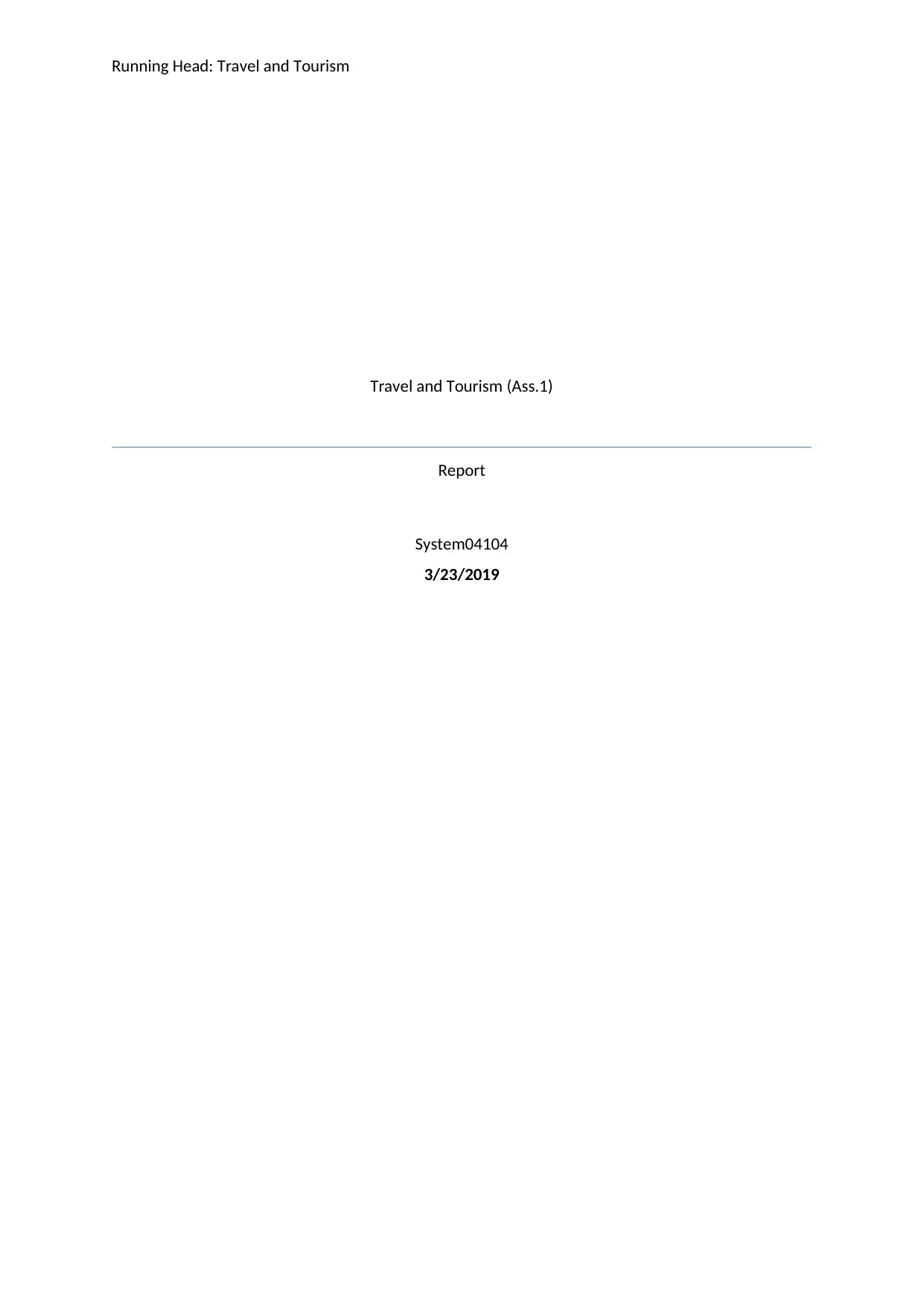
Running Head: Travel and Tourism
Travel and Tourism (Ass.1)
Report
System04104
3/23/2019
Travel and Tourism (Ass.1)
Report
System04104
3/23/2019
Paraphrase This Document
Need a fresh take? Get an instant paraphrase of this document with our AI Paraphraser
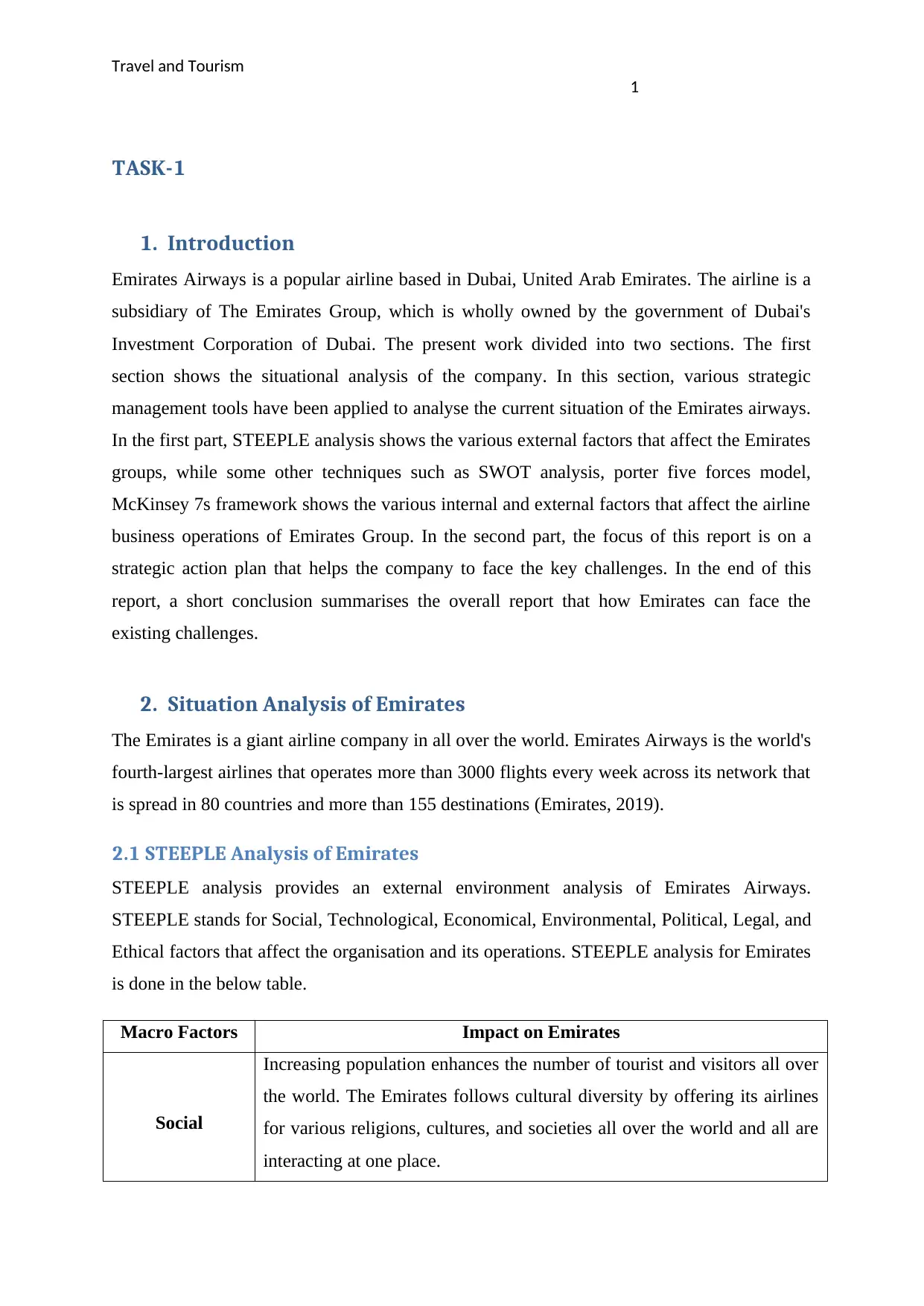
Travel and Tourism
1
TASK-1
1. Introduction
Emirates Airways is a popular airline based in Dubai, United Arab Emirates. The airline is a
subsidiary of The Emirates Group, which is wholly owned by the government of Dubai's
Investment Corporation of Dubai. The present work divided into two sections. The first
section shows the situational analysis of the company. In this section, various strategic
management tools have been applied to analyse the current situation of the Emirates airways.
In the first part, STEEPLE analysis shows the various external factors that affect the Emirates
groups, while some other techniques such as SWOT analysis, porter five forces model,
McKinsey 7s framework shows the various internal and external factors that affect the airline
business operations of Emirates Group. In the second part, the focus of this report is on a
strategic action plan that helps the company to face the key challenges. In the end of this
report, a short conclusion summarises the overall report that how Emirates can face the
existing challenges.
2. Situation Analysis of Emirates
The Emirates is a giant airline company in all over the world. Emirates Airways is the world's
fourth-largest airlines that operates more than 3000 flights every week across its network that
is spread in 80 countries and more than 155 destinations (Emirates, 2019).
2.1 STEEPLE Analysis of Emirates
STEEPLE analysis provides an external environment analysis of Emirates Airways.
STEEPLE stands for Social, Technological, Economical, Environmental, Political, Legal, and
Ethical factors that affect the organisation and its operations. STEEPLE analysis for Emirates
is done in the below table.
Macro Factors Impact on Emirates
Social
Increasing population enhances the number of tourist and visitors all over
the world. The Emirates follows cultural diversity by offering its airlines
for various religions, cultures, and societies all over the world and all are
interacting at one place.
1
TASK-1
1. Introduction
Emirates Airways is a popular airline based in Dubai, United Arab Emirates. The airline is a
subsidiary of The Emirates Group, which is wholly owned by the government of Dubai's
Investment Corporation of Dubai. The present work divided into two sections. The first
section shows the situational analysis of the company. In this section, various strategic
management tools have been applied to analyse the current situation of the Emirates airways.
In the first part, STEEPLE analysis shows the various external factors that affect the Emirates
groups, while some other techniques such as SWOT analysis, porter five forces model,
McKinsey 7s framework shows the various internal and external factors that affect the airline
business operations of Emirates Group. In the second part, the focus of this report is on a
strategic action plan that helps the company to face the key challenges. In the end of this
report, a short conclusion summarises the overall report that how Emirates can face the
existing challenges.
2. Situation Analysis of Emirates
The Emirates is a giant airline company in all over the world. Emirates Airways is the world's
fourth-largest airlines that operates more than 3000 flights every week across its network that
is spread in 80 countries and more than 155 destinations (Emirates, 2019).
2.1 STEEPLE Analysis of Emirates
STEEPLE analysis provides an external environment analysis of Emirates Airways.
STEEPLE stands for Social, Technological, Economical, Environmental, Political, Legal, and
Ethical factors that affect the organisation and its operations. STEEPLE analysis for Emirates
is done in the below table.
Macro Factors Impact on Emirates
Social
Increasing population enhances the number of tourist and visitors all over
the world. The Emirates follows cultural diversity by offering its airlines
for various religions, cultures, and societies all over the world and all are
interacting at one place.
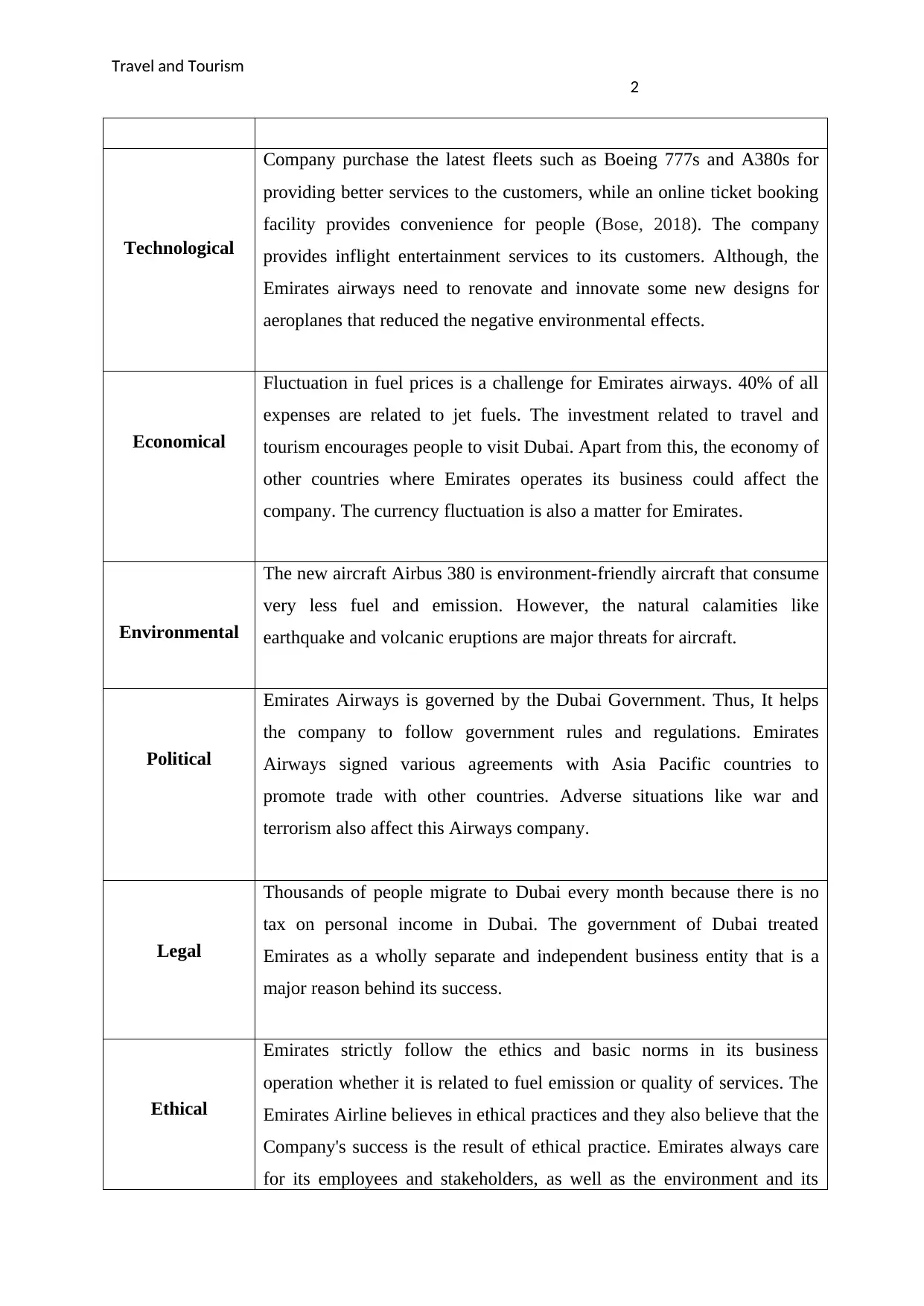
Travel and Tourism
2
Technological
Company purchase the latest fleets such as Boeing 777s and A380s for
providing better services to the customers, while an online ticket booking
facility provides convenience for people (Bose, 2018). The company
provides inflight entertainment services to its customers. Although, the
Emirates airways need to renovate and innovate some new designs for
aeroplanes that reduced the negative environmental effects.
Economical
Fluctuation in fuel prices is a challenge for Emirates airways. 40% of all
expenses are related to jet fuels. The investment related to travel and
tourism encourages people to visit Dubai. Apart from this, the economy of
other countries where Emirates operates its business could affect the
company. The currency fluctuation is also a matter for Emirates.
Environmental
The new aircraft Airbus 380 is environment-friendly aircraft that consume
very less fuel and emission. However, the natural calamities like
earthquake and volcanic eruptions are major threats for aircraft.
Political
Emirates Airways is governed by the Dubai Government. Thus, It helps
the company to follow government rules and regulations. Emirates
Airways signed various agreements with Asia Pacific countries to
promote trade with other countries. Adverse situations like war and
terrorism also affect this Airways company.
Legal
Thousands of people migrate to Dubai every month because there is no
tax on personal income in Dubai. The government of Dubai treated
Emirates as a wholly separate and independent business entity that is a
major reason behind its success.
Ethical
Emirates strictly follow the ethics and basic norms in its business
operation whether it is related to fuel emission or quality of services. The
Emirates Airline believes in ethical practices and they also believe that the
Company's success is the result of ethical practice. Emirates always care
for its employees and stakeholders, as well as the environment and its
2
Technological
Company purchase the latest fleets such as Boeing 777s and A380s for
providing better services to the customers, while an online ticket booking
facility provides convenience for people (Bose, 2018). The company
provides inflight entertainment services to its customers. Although, the
Emirates airways need to renovate and innovate some new designs for
aeroplanes that reduced the negative environmental effects.
Economical
Fluctuation in fuel prices is a challenge for Emirates airways. 40% of all
expenses are related to jet fuels. The investment related to travel and
tourism encourages people to visit Dubai. Apart from this, the economy of
other countries where Emirates operates its business could affect the
company. The currency fluctuation is also a matter for Emirates.
Environmental
The new aircraft Airbus 380 is environment-friendly aircraft that consume
very less fuel and emission. However, the natural calamities like
earthquake and volcanic eruptions are major threats for aircraft.
Political
Emirates Airways is governed by the Dubai Government. Thus, It helps
the company to follow government rules and regulations. Emirates
Airways signed various agreements with Asia Pacific countries to
promote trade with other countries. Adverse situations like war and
terrorism also affect this Airways company.
Legal
Thousands of people migrate to Dubai every month because there is no
tax on personal income in Dubai. The government of Dubai treated
Emirates as a wholly separate and independent business entity that is a
major reason behind its success.
Ethical
Emirates strictly follow the ethics and basic norms in its business
operation whether it is related to fuel emission or quality of services. The
Emirates Airline believes in ethical practices and they also believe that the
Company's success is the result of ethical practice. Emirates always care
for its employees and stakeholders, as well as the environment and its
⊘ This is a preview!⊘
Do you want full access?
Subscribe today to unlock all pages.

Trusted by 1+ million students worldwide
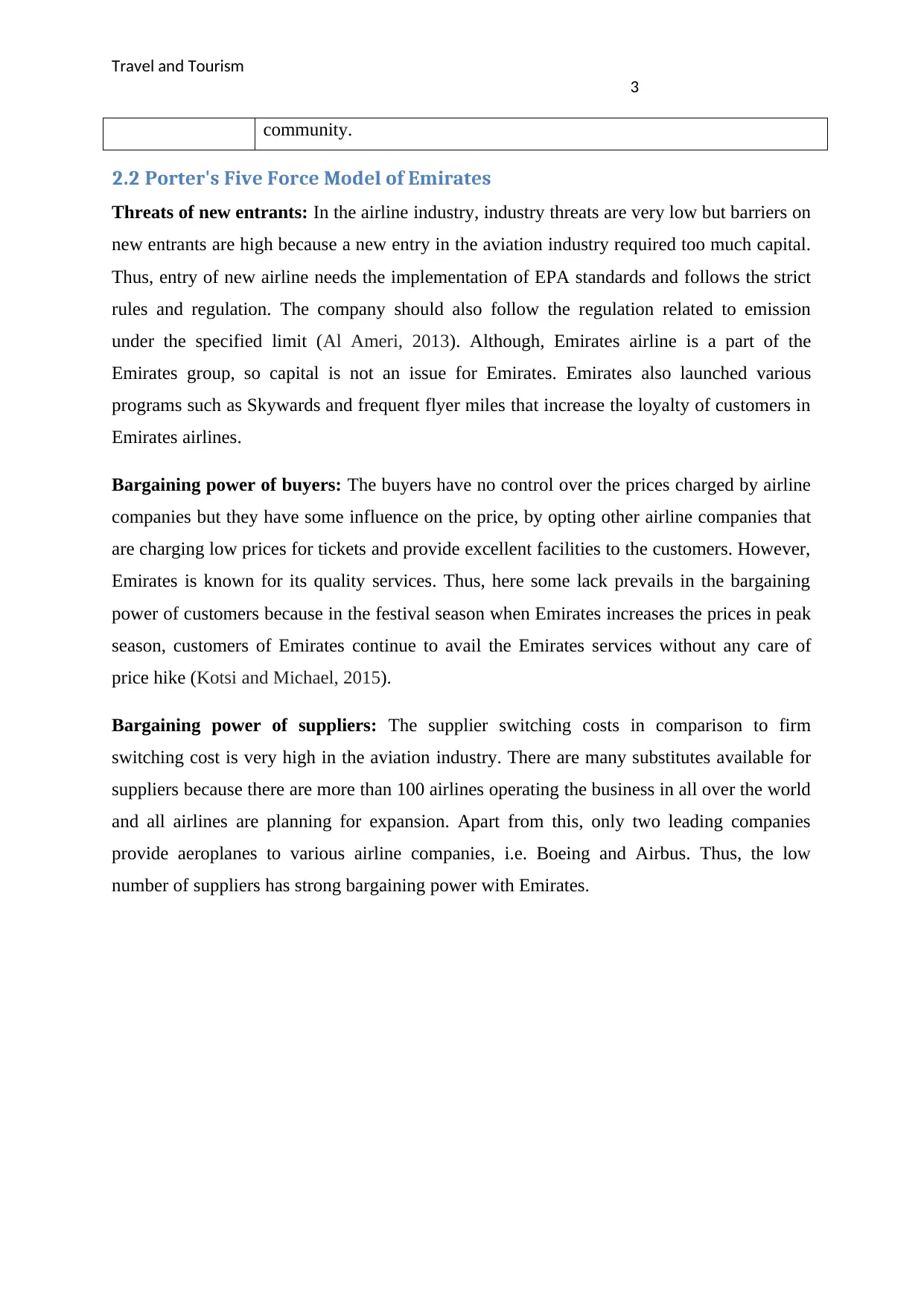
Travel and Tourism
3
community.
2.2 Porter's Five Force Model of Emirates
Threats of new entrants: In the airline industry, industry threats are very low but barriers on
new entrants are high because a new entry in the aviation industry required too much capital.
Thus, entry of new airline needs the implementation of EPA standards and follows the strict
rules and regulation. The company should also follow the regulation related to emission
under the specified limit (Al Ameri, 2013). Although, Emirates airline is a part of the
Emirates group, so capital is not an issue for Emirates. Emirates also launched various
programs such as Skywards and frequent flyer miles that increase the loyalty of customers in
Emirates airlines.
Bargaining power of buyers: The buyers have no control over the prices charged by airline
companies but they have some influence on the price, by opting other airline companies that
are charging low prices for tickets and provide excellent facilities to the customers. However,
Emirates is known for its quality services. Thus, here some lack prevails in the bargaining
power of customers because in the festival season when Emirates increases the prices in peak
season, customers of Emirates continue to avail the Emirates services without any care of
price hike (Kotsi and Michael, 2015).
Bargaining power of suppliers: The supplier switching costs in comparison to firm
switching cost is very high in the aviation industry. There are many substitutes available for
suppliers because there are more than 100 airlines operating the business in all over the world
and all airlines are planning for expansion. Apart from this, only two leading companies
provide aeroplanes to various airline companies, i.e. Boeing and Airbus. Thus, the low
number of suppliers has strong bargaining power with Emirates.
3
community.
2.2 Porter's Five Force Model of Emirates
Threats of new entrants: In the airline industry, industry threats are very low but barriers on
new entrants are high because a new entry in the aviation industry required too much capital.
Thus, entry of new airline needs the implementation of EPA standards and follows the strict
rules and regulation. The company should also follow the regulation related to emission
under the specified limit (Al Ameri, 2013). Although, Emirates airline is a part of the
Emirates group, so capital is not an issue for Emirates. Emirates also launched various
programs such as Skywards and frequent flyer miles that increase the loyalty of customers in
Emirates airlines.
Bargaining power of buyers: The buyers have no control over the prices charged by airline
companies but they have some influence on the price, by opting other airline companies that
are charging low prices for tickets and provide excellent facilities to the customers. However,
Emirates is known for its quality services. Thus, here some lack prevails in the bargaining
power of customers because in the festival season when Emirates increases the prices in peak
season, customers of Emirates continue to avail the Emirates services without any care of
price hike (Kotsi and Michael, 2015).
Bargaining power of suppliers: The supplier switching costs in comparison to firm
switching cost is very high in the aviation industry. There are many substitutes available for
suppliers because there are more than 100 airlines operating the business in all over the world
and all airlines are planning for expansion. Apart from this, only two leading companies
provide aeroplanes to various airline companies, i.e. Boeing and Airbus. Thus, the low
number of suppliers has strong bargaining power with Emirates.
Paraphrase This Document
Need a fresh take? Get an instant paraphrase of this document with our AI Paraphraser

Travel and Tourism
4
(Source: Vij and Vij, 2012)
The threat of Substitute products: The threat of substitute products/services in the airline
industry is very low and Emirates faces a very low level of threat of substitute products
because of its standard services and size of airlines. The other substitutes of airlines are train,
boats, car, and other automobiles but these modes of transportation are not as popular as an
airline when we consider international travelling. In international travelling, air travel is the
popular and main choice available for customers (CGMA, 2013).
Competitive Rivalry: Competitive rivalry is very high in the global aviation industry
because there are large numbers of companies operating airlines business globally. The high
degree of competitive rivalry is putting so much pressure on airline companies to develop a
strategy that provides financial supremacy on others. Better service quality, low prices, and
updated aircraft career provide an edge over other competitors (O'Connell and Williams,
2011). Although the Emirates is a national airline of Dubai, it faces lots of global pressure
from other airlines such as Qatar Airways, Air France, British Airways etc. These companies
have a large market share all over the world and provide quality services to customers.
Forces Impact
Threats of new entrants Low
Bargaining power of buyers Moderate
Bargaining power of suppliers High
The threat of Substitute products Moderate
Competitive Rivalry Moderate
4
(Source: Vij and Vij, 2012)
The threat of Substitute products: The threat of substitute products/services in the airline
industry is very low and Emirates faces a very low level of threat of substitute products
because of its standard services and size of airlines. The other substitutes of airlines are train,
boats, car, and other automobiles but these modes of transportation are not as popular as an
airline when we consider international travelling. In international travelling, air travel is the
popular and main choice available for customers (CGMA, 2013).
Competitive Rivalry: Competitive rivalry is very high in the global aviation industry
because there are large numbers of companies operating airlines business globally. The high
degree of competitive rivalry is putting so much pressure on airline companies to develop a
strategy that provides financial supremacy on others. Better service quality, low prices, and
updated aircraft career provide an edge over other competitors (O'Connell and Williams,
2011). Although the Emirates is a national airline of Dubai, it faces lots of global pressure
from other airlines such as Qatar Airways, Air France, British Airways etc. These companies
have a large market share all over the world and provide quality services to customers.
Forces Impact
Threats of new entrants Low
Bargaining power of buyers Moderate
Bargaining power of suppliers High
The threat of Substitute products Moderate
Competitive Rivalry Moderate

Travel and Tourism
5
2.3 Analysis of the internal environment of Emirates Using McKinsey 7S
Framework
Strategy: Emirates Airlines gives importance to its stakeholders, especially to its client. As
Emirates is committed to the diversity of its clients, the company mainly focuses on
providing excellent services to its customers through a proper diversity management
program. Emirates Airways is also known for its focus-leadership strategy. Overall, it can be
said that Emirates have a good strategy that is committed and supportive of organisational
operations (Sutton, 2016).
Structure: The structure of Emirates Airways is shown in the below figure:
(Source: Abeyratne, 2018)
Systems: Any airways company requires a good quality IT system and it is the major issues
in Emirates Airways. Emirates Airways needs high-tech and high-qualified IT system, which
5
2.3 Analysis of the internal environment of Emirates Using McKinsey 7S
Framework
Strategy: Emirates Airlines gives importance to its stakeholders, especially to its client. As
Emirates is committed to the diversity of its clients, the company mainly focuses on
providing excellent services to its customers through a proper diversity management
program. Emirates Airways is also known for its focus-leadership strategy. Overall, it can be
said that Emirates have a good strategy that is committed and supportive of organisational
operations (Sutton, 2016).
Structure: The structure of Emirates Airways is shown in the below figure:
(Source: Abeyratne, 2018)
Systems: Any airways company requires a good quality IT system and it is the major issues
in Emirates Airways. Emirates Airways needs high-tech and high-qualified IT system, which
⊘ This is a preview!⊘
Do you want full access?
Subscribe today to unlock all pages.

Trusted by 1+ million students worldwide

Travel and Tourism
6
is required to manage and control all the activities in Emirates Branches and its business
operation.
Style: Emirates is known for its focus leadership style because the leadership style of the
company is a "family style." The leaders of Emirates are the democratic type of leaders, who
inspires and motivates the people and subordinates in the organisation. The decision taken by
Emirates is also influenced by its stakeholders.
Staff: Emirates provides the best salary package for their employee that is based on the
labour law. Apart from this, Emirates share its profit with eligible staff based on company
performance. Emirates also provide concession and rebates in the tickets to its staff member
and for their families.
Skills: Emirates focuses on skills development programs and its importance in the aviation
industry. Emirates airways have a training centre named ‘Emirates Aviation University’,
which helps the company to hire new talented and skilled employees. Emirates has also an in-
house training and development centre.
Shared Vision: The Emirates Airline believes in ethical practices and they also believe that
the Company's success is the result of ethical practice. Emirates always care for its employees
and stakeholders, as well as the environment and its community (Redpath, O'Connell, and
Warnock-Smith, 2017).
2.4 SWOT Analysis of Emirates
SWOT stands for Strength, Weakness, Opportunities, and Threats. The SWOT analysis helps
to know the internal factors that are strength and weakness of the Emirates, while the
opportunities and threats belong to the external factors.
Strength: Emirates is one of the leading airline companies in the world. Emirates have more
than 250 fleets and it flies six continents. Dubai is the hub of Emirates airline and this city is
also known as a famous tourist destination. Emirates airline reflects the image of Dubai city,
which leads to a positive brand image among people. The role of amenities has also played a
major role in the brand recognition of Emirates airline. Emirates employ people from various
continents in the world. The workforce of Emirates consists of more than160 nationalities.
The diversity with superb talent in the Emirates airline makes it famous global airline
organisation (O’Connell and Bueno, 2018). Emirates Airlines is known for its hunger in
6
is required to manage and control all the activities in Emirates Branches and its business
operation.
Style: Emirates is known for its focus leadership style because the leadership style of the
company is a "family style." The leaders of Emirates are the democratic type of leaders, who
inspires and motivates the people and subordinates in the organisation. The decision taken by
Emirates is also influenced by its stakeholders.
Staff: Emirates provides the best salary package for their employee that is based on the
labour law. Apart from this, Emirates share its profit with eligible staff based on company
performance. Emirates also provide concession and rebates in the tickets to its staff member
and for their families.
Skills: Emirates focuses on skills development programs and its importance in the aviation
industry. Emirates airways have a training centre named ‘Emirates Aviation University’,
which helps the company to hire new talented and skilled employees. Emirates has also an in-
house training and development centre.
Shared Vision: The Emirates Airline believes in ethical practices and they also believe that
the Company's success is the result of ethical practice. Emirates always care for its employees
and stakeholders, as well as the environment and its community (Redpath, O'Connell, and
Warnock-Smith, 2017).
2.4 SWOT Analysis of Emirates
SWOT stands for Strength, Weakness, Opportunities, and Threats. The SWOT analysis helps
to know the internal factors that are strength and weakness of the Emirates, while the
opportunities and threats belong to the external factors.
Strength: Emirates is one of the leading airline companies in the world. Emirates have more
than 250 fleets and it flies six continents. Dubai is the hub of Emirates airline and this city is
also known as a famous tourist destination. Emirates airline reflects the image of Dubai city,
which leads to a positive brand image among people. The role of amenities has also played a
major role in the brand recognition of Emirates airline. Emirates employ people from various
continents in the world. The workforce of Emirates consists of more than160 nationalities.
The diversity with superb talent in the Emirates airline makes it famous global airline
organisation (O’Connell and Bueno, 2018). Emirates Airlines is known for its hunger in
Paraphrase This Document
Need a fresh take? Get an instant paraphrase of this document with our AI Paraphraser

Travel and Tourism
7
expansion and visibility of airline in all over the world. The Emirates airline has signed many
agreements with a number of famous football teams such as Real Madrid, Arsenal, and AC
Milan etc. (Hubbard, Rice, and Galvin, 2015).
Weakness: Emirates has recently witnessed a decline in the demand after continuous growth
in the airline industry. Another weakness of Emirates is that it reduced the capacity on some
of its airline routes, i.e. Los Angeles, Lauderdale etc. Apart from this, some other Airlines
blamed Emirates airline that it is receiving government financial help in the form of
subsidies. The other blame is that Emirates is not paying taxes in the country. These
allegations leave a negative impact in the mind of people and it also demolishes the image of
Emirates that it creates. However, Emirates has denied all these allegations.
Opportunities: Though Emirates operating its airline business in more than 80 countries, it
still believes in the international expansion strategy of its airline business. The rising in
demand for convenient and affordable airline travelling from the customers provides an
opportunity to Emirates for the subsidiary budget for the airline. Apart from this, the Emirates
airline has more opportunities in innovation and developing new generation advance airline
and aviation services, because it always focuses on the expansion of its airline services.
Threats: The major threat for the Emirates airlines is a large number of competitors in the
airline industry. The continuous rise in fuel price of planes is also a major concern for the
Emirates airline. The other airline companies such as Air Arabia and Al Jazeera Airways
provide more affordable travelling for the customers with great convenience to the customers
and it is also a threat for the Emirates airline (Huggings and Izushi, 2011).
3. Key Challenges for Emirates
On the above situational analysis, the key challenges for Emirates Airways are as follow:
1. Emirates Airways charges premium prices for its services.
2. A large number of national and international companies give strong competition by
giving quality and affordable services to customers at low prices.
3. The Airbus A380 and Boeing 777-300 require more cabin crew per flight and thus
Emirates is facing the shortage of staffs for long-haul routes.
4. Emirates should find out an innovative way to teach and train its crew staffs.
7
expansion and visibility of airline in all over the world. The Emirates airline has signed many
agreements with a number of famous football teams such as Real Madrid, Arsenal, and AC
Milan etc. (Hubbard, Rice, and Galvin, 2015).
Weakness: Emirates has recently witnessed a decline in the demand after continuous growth
in the airline industry. Another weakness of Emirates is that it reduced the capacity on some
of its airline routes, i.e. Los Angeles, Lauderdale etc. Apart from this, some other Airlines
blamed Emirates airline that it is receiving government financial help in the form of
subsidies. The other blame is that Emirates is not paying taxes in the country. These
allegations leave a negative impact in the mind of people and it also demolishes the image of
Emirates that it creates. However, Emirates has denied all these allegations.
Opportunities: Though Emirates operating its airline business in more than 80 countries, it
still believes in the international expansion strategy of its airline business. The rising in
demand for convenient and affordable airline travelling from the customers provides an
opportunity to Emirates for the subsidiary budget for the airline. Apart from this, the Emirates
airline has more opportunities in innovation and developing new generation advance airline
and aviation services, because it always focuses on the expansion of its airline services.
Threats: The major threat for the Emirates airlines is a large number of competitors in the
airline industry. The continuous rise in fuel price of planes is also a major concern for the
Emirates airline. The other airline companies such as Air Arabia and Al Jazeera Airways
provide more affordable travelling for the customers with great convenience to the customers
and it is also a threat for the Emirates airline (Huggings and Izushi, 2011).
3. Key Challenges for Emirates
On the above situational analysis, the key challenges for Emirates Airways are as follow:
1. Emirates Airways charges premium prices for its services.
2. A large number of national and international companies give strong competition by
giving quality and affordable services to customers at low prices.
3. The Airbus A380 and Boeing 777-300 require more cabin crew per flight and thus
Emirates is facing the shortage of staffs for long-haul routes.
4. Emirates should find out an innovative way to teach and train its crew staffs.

Travel and Tourism
8
5. The premium price of tickets helps another player to exist in the market. They provide
affordable service to its customer and Emirates loses its customers. Thus, Emirates
should focus on accommodate personalised needs of all passengers.
6. Unfilled seats represent a threat cost to the operator.
8
5. The premium price of tickets helps another player to exist in the market. They provide
affordable service to its customer and Emirates loses its customers. Thus, Emirates
should focus on accommodate personalised needs of all passengers.
6. Unfilled seats represent a threat cost to the operator.
⊘ This is a preview!⊘
Do you want full access?
Subscribe today to unlock all pages.

Trusted by 1+ million students worldwide
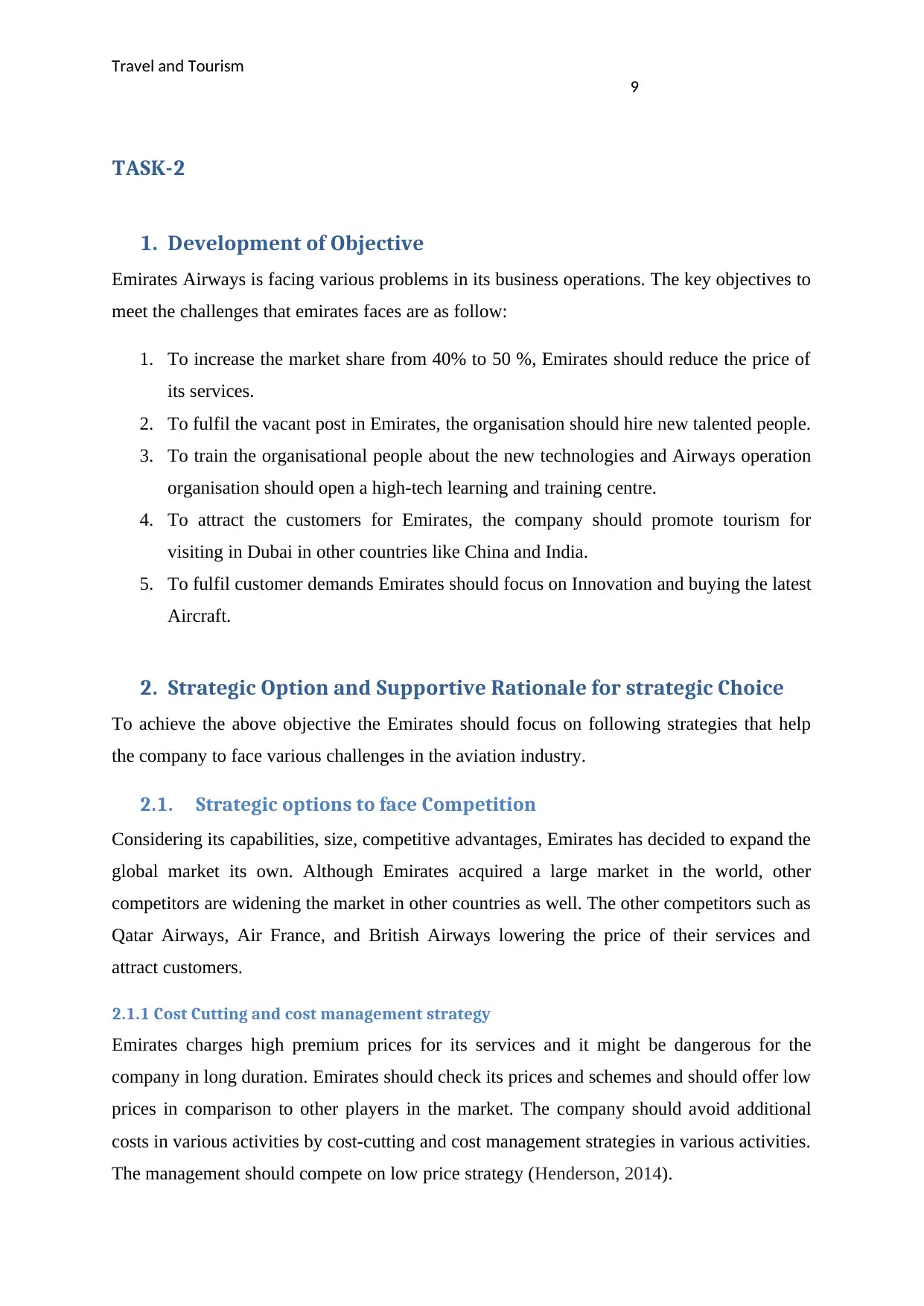
Travel and Tourism
9
TASK-2
1. Development of Objective
Emirates Airways is facing various problems in its business operations. The key objectives to
meet the challenges that emirates faces are as follow:
1. To increase the market share from 40% to 50 %, Emirates should reduce the price of
its services.
2. To fulfil the vacant post in Emirates, the organisation should hire new talented people.
3. To train the organisational people about the new technologies and Airways operation
organisation should open a high-tech learning and training centre.
4. To attract the customers for Emirates, the company should promote tourism for
visiting in Dubai in other countries like China and India.
5. To fulfil customer demands Emirates should focus on Innovation and buying the latest
Aircraft.
2. Strategic Option and Supportive Rationale for strategic Choice
To achieve the above objective the Emirates should focus on following strategies that help
the company to face various challenges in the aviation industry.
2.1. Strategic options to face Competition
Considering its capabilities, size, competitive advantages, Emirates has decided to expand the
global market its own. Although Emirates acquired a large market in the world, other
competitors are widening the market in other countries as well. The other competitors such as
Qatar Airways, Air France, and British Airways lowering the price of their services and
attract customers.
2.1.1 Cost Cutting and cost management strategy
Emirates charges high premium prices for its services and it might be dangerous for the
company in long duration. Emirates should check its prices and schemes and should offer low
prices in comparison to other players in the market. The company should avoid additional
costs in various activities by cost-cutting and cost management strategies in various activities.
The management should compete on low price strategy (Henderson, 2014).
9
TASK-2
1. Development of Objective
Emirates Airways is facing various problems in its business operations. The key objectives to
meet the challenges that emirates faces are as follow:
1. To increase the market share from 40% to 50 %, Emirates should reduce the price of
its services.
2. To fulfil the vacant post in Emirates, the organisation should hire new talented people.
3. To train the organisational people about the new technologies and Airways operation
organisation should open a high-tech learning and training centre.
4. To attract the customers for Emirates, the company should promote tourism for
visiting in Dubai in other countries like China and India.
5. To fulfil customer demands Emirates should focus on Innovation and buying the latest
Aircraft.
2. Strategic Option and Supportive Rationale for strategic Choice
To achieve the above objective the Emirates should focus on following strategies that help
the company to face various challenges in the aviation industry.
2.1. Strategic options to face Competition
Considering its capabilities, size, competitive advantages, Emirates has decided to expand the
global market its own. Although Emirates acquired a large market in the world, other
competitors are widening the market in other countries as well. The other competitors such as
Qatar Airways, Air France, and British Airways lowering the price of their services and
attract customers.
2.1.1 Cost Cutting and cost management strategy
Emirates charges high premium prices for its services and it might be dangerous for the
company in long duration. Emirates should check its prices and schemes and should offer low
prices in comparison to other players in the market. The company should avoid additional
costs in various activities by cost-cutting and cost management strategies in various activities.
The management should compete on low price strategy (Henderson, 2014).
Paraphrase This Document
Need a fresh take? Get an instant paraphrase of this document with our AI Paraphraser
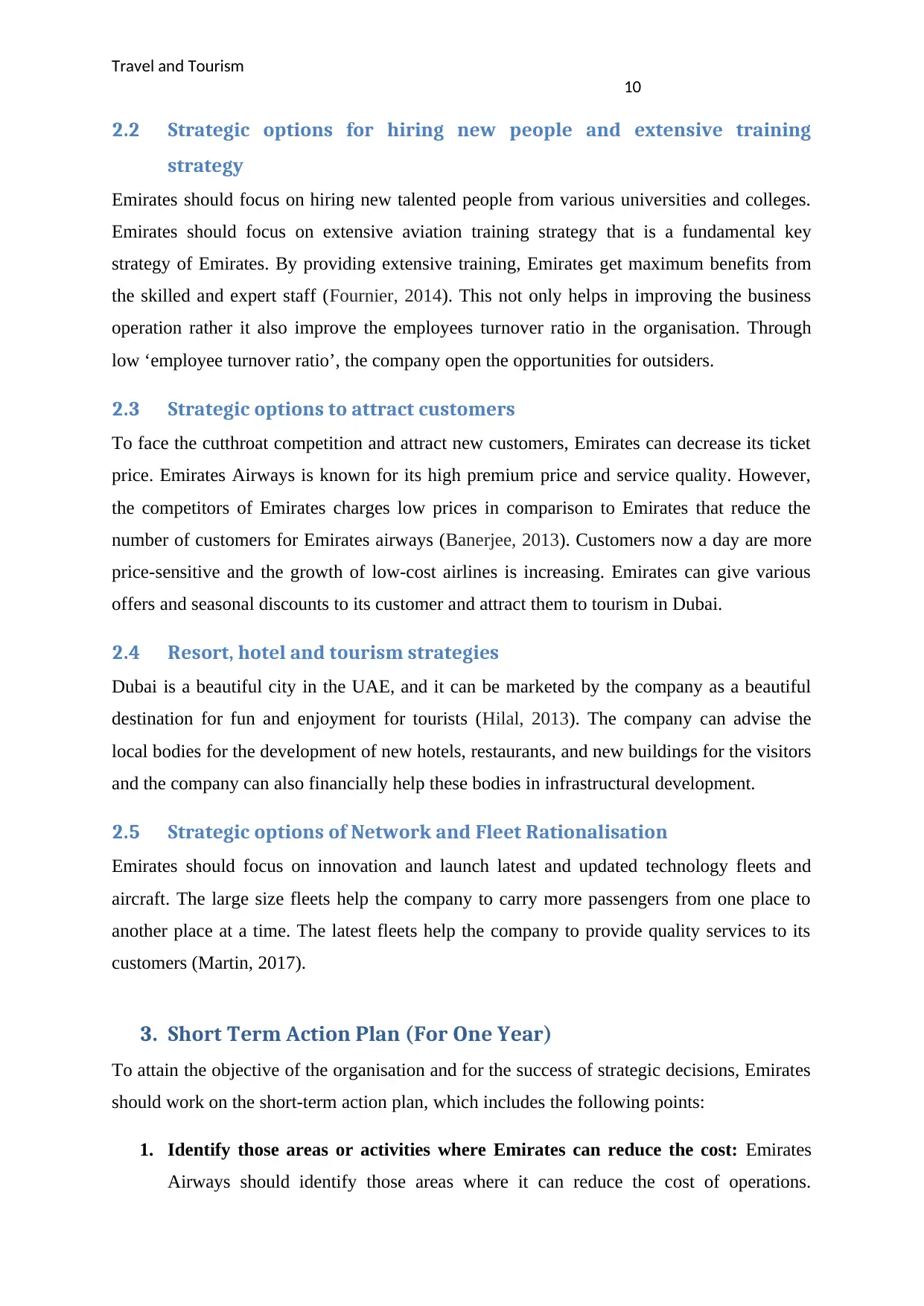
Travel and Tourism
10
2.2 Strategic options for hiring new people and extensive training
strategy
Emirates should focus on hiring new talented people from various universities and colleges.
Emirates should focus on extensive aviation training strategy that is a fundamental key
strategy of Emirates. By providing extensive training, Emirates get maximum benefits from
the skilled and expert staff (Fournier, 2014). This not only helps in improving the business
operation rather it also improve the employees turnover ratio in the organisation. Through
low ‘employee turnover ratio’, the company open the opportunities for outsiders.
2.3 Strategic options to attract customers
To face the cutthroat competition and attract new customers, Emirates can decrease its ticket
price. Emirates Airways is known for its high premium price and service quality. However,
the competitors of Emirates charges low prices in comparison to Emirates that reduce the
number of customers for Emirates airways (Banerjee, 2013). Customers now a day are more
price-sensitive and the growth of low-cost airlines is increasing. Emirates can give various
offers and seasonal discounts to its customer and attract them to tourism in Dubai.
2.4 Resort, hotel and tourism strategies
Dubai is a beautiful city in the UAE, and it can be marketed by the company as a beautiful
destination for fun and enjoyment for tourists (Hilal, 2013). The company can advise the
local bodies for the development of new hotels, restaurants, and new buildings for the visitors
and the company can also financially help these bodies in infrastructural development.
2.5 Strategic options of Network and Fleet Rationalisation
Emirates should focus on innovation and launch latest and updated technology fleets and
aircraft. The large size fleets help the company to carry more passengers from one place to
another place at a time. The latest fleets help the company to provide quality services to its
customers (Martin, 2017).
3. Short Term Action Plan (For One Year)
To attain the objective of the organisation and for the success of strategic decisions, Emirates
should work on the short-term action plan, which includes the following points:
1. Identify those areas or activities where Emirates can reduce the cost: Emirates
Airways should identify those areas where it can reduce the cost of operations.
10
2.2 Strategic options for hiring new people and extensive training
strategy
Emirates should focus on hiring new talented people from various universities and colleges.
Emirates should focus on extensive aviation training strategy that is a fundamental key
strategy of Emirates. By providing extensive training, Emirates get maximum benefits from
the skilled and expert staff (Fournier, 2014). This not only helps in improving the business
operation rather it also improve the employees turnover ratio in the organisation. Through
low ‘employee turnover ratio’, the company open the opportunities for outsiders.
2.3 Strategic options to attract customers
To face the cutthroat competition and attract new customers, Emirates can decrease its ticket
price. Emirates Airways is known for its high premium price and service quality. However,
the competitors of Emirates charges low prices in comparison to Emirates that reduce the
number of customers for Emirates airways (Banerjee, 2013). Customers now a day are more
price-sensitive and the growth of low-cost airlines is increasing. Emirates can give various
offers and seasonal discounts to its customer and attract them to tourism in Dubai.
2.4 Resort, hotel and tourism strategies
Dubai is a beautiful city in the UAE, and it can be marketed by the company as a beautiful
destination for fun and enjoyment for tourists (Hilal, 2013). The company can advise the
local bodies for the development of new hotels, restaurants, and new buildings for the visitors
and the company can also financially help these bodies in infrastructural development.
2.5 Strategic options of Network and Fleet Rationalisation
Emirates should focus on innovation and launch latest and updated technology fleets and
aircraft. The large size fleets help the company to carry more passengers from one place to
another place at a time. The latest fleets help the company to provide quality services to its
customers (Martin, 2017).
3. Short Term Action Plan (For One Year)
To attain the objective of the organisation and for the success of strategic decisions, Emirates
should work on the short-term action plan, which includes the following points:
1. Identify those areas or activities where Emirates can reduce the cost: Emirates
Airways should identify those areas where it can reduce the cost of operations.
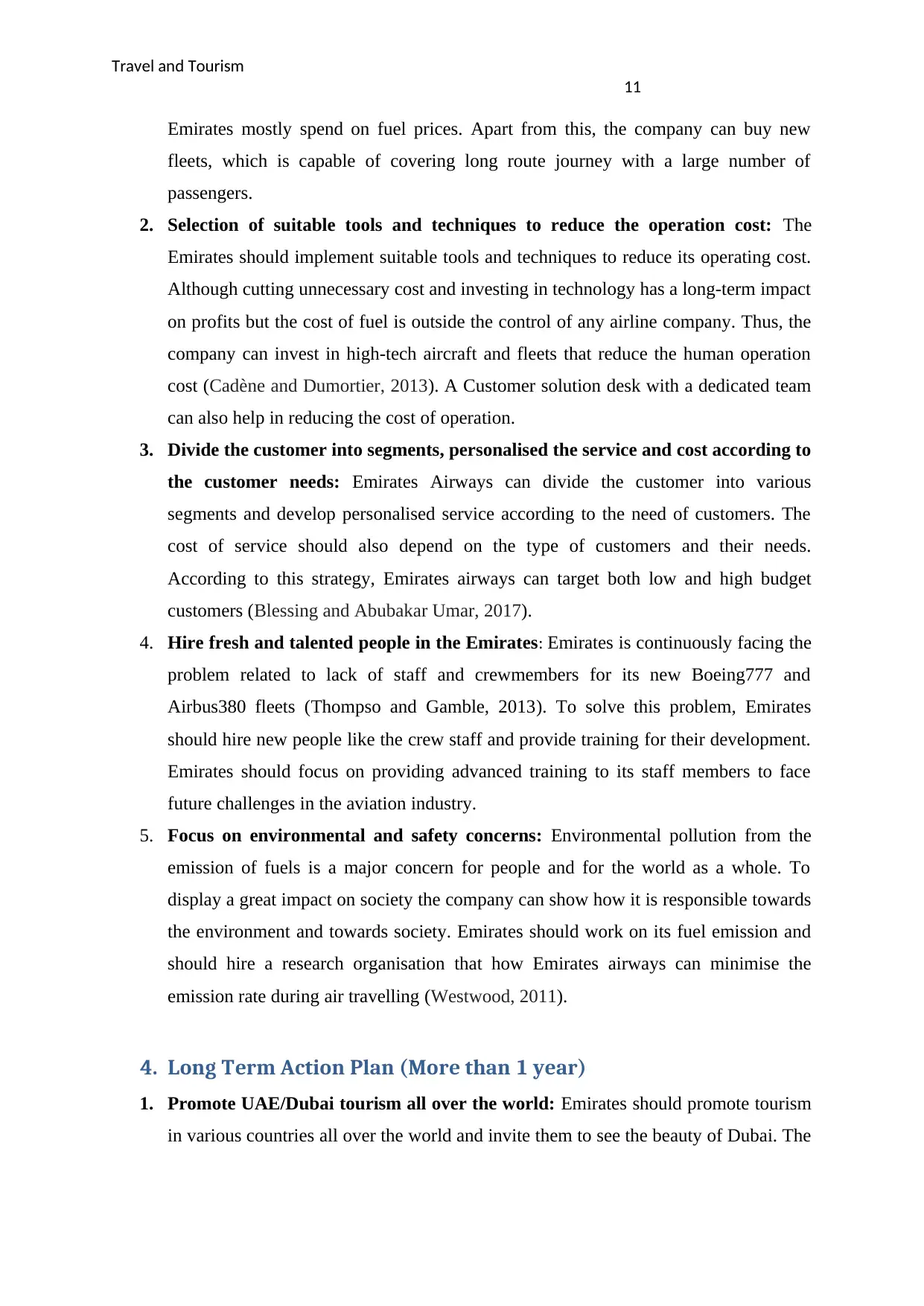
Travel and Tourism
11
Emirates mostly spend on fuel prices. Apart from this, the company can buy new
fleets, which is capable of covering long route journey with a large number of
passengers.
2. Selection of suitable tools and techniques to reduce the operation cost: The
Emirates should implement suitable tools and techniques to reduce its operating cost.
Although cutting unnecessary cost and investing in technology has a long-term impact
on profits but the cost of fuel is outside the control of any airline company. Thus, the
company can invest in high-tech aircraft and fleets that reduce the human operation
cost (Cadène and Dumortier, 2013). A Customer solution desk with a dedicated team
can also help in reducing the cost of operation.
3. Divide the customer into segments, personalised the service and cost according to
the customer needs: Emirates Airways can divide the customer into various
segments and develop personalised service according to the need of customers. The
cost of service should also depend on the type of customers and their needs.
According to this strategy, Emirates airways can target both low and high budget
customers (Blessing and Abubakar Umar, 2017).
4. Hire fresh and talented people in the Emirates: Emirates is continuously facing the
problem related to lack of staff and crewmembers for its new Boeing777 and
Airbus380 fleets (Thompso and Gamble, 2013). To solve this problem, Emirates
should hire new people like the crew staff and provide training for their development.
Emirates should focus on providing advanced training to its staff members to face
future challenges in the aviation industry.
5. Focus on environmental and safety concerns: Environmental pollution from the
emission of fuels is a major concern for people and for the world as a whole. To
display a great impact on society the company can show how it is responsible towards
the environment and towards society. Emirates should work on its fuel emission and
should hire a research organisation that how Emirates airways can minimise the
emission rate during air travelling (Westwood, 2011).
4. Long Term Action Plan (More than 1 year)
1. Promote UAE/Dubai tourism all over the world: Emirates should promote tourism
in various countries all over the world and invite them to see the beauty of Dubai. The
11
Emirates mostly spend on fuel prices. Apart from this, the company can buy new
fleets, which is capable of covering long route journey with a large number of
passengers.
2. Selection of suitable tools and techniques to reduce the operation cost: The
Emirates should implement suitable tools and techniques to reduce its operating cost.
Although cutting unnecessary cost and investing in technology has a long-term impact
on profits but the cost of fuel is outside the control of any airline company. Thus, the
company can invest in high-tech aircraft and fleets that reduce the human operation
cost (Cadène and Dumortier, 2013). A Customer solution desk with a dedicated team
can also help in reducing the cost of operation.
3. Divide the customer into segments, personalised the service and cost according to
the customer needs: Emirates Airways can divide the customer into various
segments and develop personalised service according to the need of customers. The
cost of service should also depend on the type of customers and their needs.
According to this strategy, Emirates airways can target both low and high budget
customers (Blessing and Abubakar Umar, 2017).
4. Hire fresh and talented people in the Emirates: Emirates is continuously facing the
problem related to lack of staff and crewmembers for its new Boeing777 and
Airbus380 fleets (Thompso and Gamble, 2013). To solve this problem, Emirates
should hire new people like the crew staff and provide training for their development.
Emirates should focus on providing advanced training to its staff members to face
future challenges in the aviation industry.
5. Focus on environmental and safety concerns: Environmental pollution from the
emission of fuels is a major concern for people and for the world as a whole. To
display a great impact on society the company can show how it is responsible towards
the environment and towards society. Emirates should work on its fuel emission and
should hire a research organisation that how Emirates airways can minimise the
emission rate during air travelling (Westwood, 2011).
4. Long Term Action Plan (More than 1 year)
1. Promote UAE/Dubai tourism all over the world: Emirates should promote tourism
in various countries all over the world and invite them to see the beauty of Dubai. The
⊘ This is a preview!⊘
Do you want full access?
Subscribe today to unlock all pages.

Trusted by 1+ million students worldwide
1 out of 17
Related Documents
Your All-in-One AI-Powered Toolkit for Academic Success.
+13062052269
info@desklib.com
Available 24*7 on WhatsApp / Email
![[object Object]](/_next/static/media/star-bottom.7253800d.svg)
Unlock your academic potential
Copyright © 2020–2025 A2Z Services. All Rights Reserved. Developed and managed by ZUCOL.




